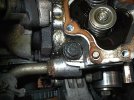Tom Ginefra
True Classic
I've been driving the car regularly, since I completed my engine rebuild in mid November of 23. A total of approximately 4 months.
I followed the recommended re-torque procedure for the cylinder head, as well as a general checking of all nuts and bolts (tightening those that felt like they should be snugged up). A few days ago I noticed a fair amount of oil had accumulated in the wells around the base of the 2 Left Rear Headbolts. I checked the bolts and they were torqued to 69 ft/lbs. I cleaned the area to better identify the source of the leak, and drove the car. The next day I noticed that the vertical side behind the 2 head bolts had a new film of oil there and the gasket between the cambox and the cylinder head looked to be the source of the leak. I took off the valve cover and checked how tight each of the cambox bolts were. I decided to re-torque all of them and noticed a couple of them were easier to loosen than the others, (but they weren't near where the leak is.) It's also worth noting that prior to assembly I carefully checked the surfaces between the cambox and the cylinder head and they were both true, flat and free of any nicks or visible distortions of any kind. AND again, this wasn't leaking before. This is a new development.
I checked the manual again and was reminded that the torque for these bolts is an incredibly low 14 lbs. The term "Cambox" does not appear anywhere in the text. So, (as I did originally) I assumed the reference to "Cylinder Head Extension bolts" was the cambox bolts. I retorqued the bolts to 16lbs in an effort to better squeeze the gasket, The leak "albeit slightly less" still persists.

My questions are as follows;
1. Should I have applied any kind of a gasket sealer to the cambox gasket?
2. Is the torque rating for these bolts "really" only 14 lbs, or is that a possible misprint?
3. Has anyone had a similar experience and what did you do to correct it?
Any assistance would be appreciated
I followed the recommended re-torque procedure for the cylinder head, as well as a general checking of all nuts and bolts (tightening those that felt like they should be snugged up). A few days ago I noticed a fair amount of oil had accumulated in the wells around the base of the 2 Left Rear Headbolts. I checked the bolts and they were torqued to 69 ft/lbs. I cleaned the area to better identify the source of the leak, and drove the car. The next day I noticed that the vertical side behind the 2 head bolts had a new film of oil there and the gasket between the cambox and the cylinder head looked to be the source of the leak. I took off the valve cover and checked how tight each of the cambox bolts were. I decided to re-torque all of them and noticed a couple of them were easier to loosen than the others, (but they weren't near where the leak is.) It's also worth noting that prior to assembly I carefully checked the surfaces between the cambox and the cylinder head and they were both true, flat and free of any nicks or visible distortions of any kind. AND again, this wasn't leaking before. This is a new development.
I checked the manual again and was reminded that the torque for these bolts is an incredibly low 14 lbs. The term "Cambox" does not appear anywhere in the text. So, (as I did originally) I assumed the reference to "Cylinder Head Extension bolts" was the cambox bolts. I retorqued the bolts to 16lbs in an effort to better squeeze the gasket, The leak "albeit slightly less" still persists.
My questions are as follows;
1. Should I have applied any kind of a gasket sealer to the cambox gasket?
2. Is the torque rating for these bolts "really" only 14 lbs, or is that a possible misprint?
3. Has anyone had a similar experience and what did you do to correct it?
Any assistance would be appreciated

